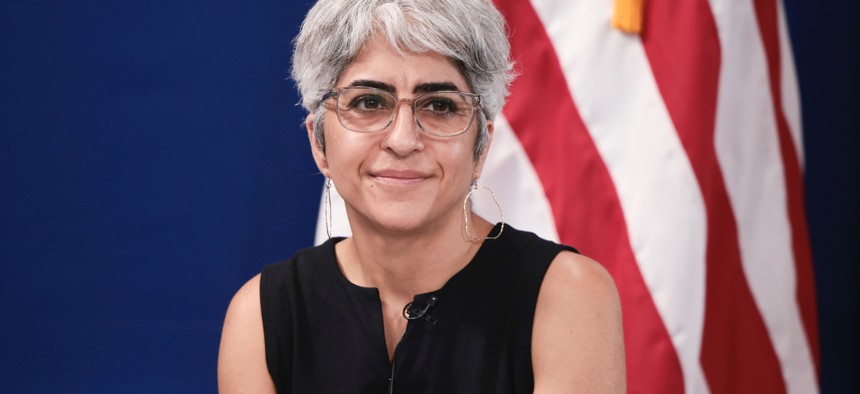
OPM Director Kiran Ahuja said the agency's equity action plan includes details on the capability to analyze demographic data supplied by job applicants. Anna Moneymaker / Getty Images
OPM’s 2024 equity goals aim to expand data-based approach
The federal government’s HR agency plans to expand the use of data to analyze recruitment barriers for underserved communities as well as outreach at minority-serving educational institutions in the coming year.
The Office of Personnel Management on Wednesday announced its latest plans to harness data to identify and combat equity barriers within the federal workforce and improve recruitment at educational institutions focused on underserved communities.
OPM joined much of the federal government this week in publishing the 2023 iteration of its annual equity action plan, covering accomplishments made in fiscal 2023 and outlining strategies to improve support for minorities and other underserved communities in fiscal 2024. The publication of agency equity plans stems from President Biden’s two executive orders that seek to improve diversity, equity, inclusion and accessibility both within the federal workforce and in delivery of services to the American public.
“Since day one of our administration, President Biden and I have been fully committed to ensuring that every person in America has equitable access to opportunity and the ability to thrive,” said Vice President Kamala Harris in a statement. “[As] we mark the one-year anniversary of the second equity executive order, we celebrate the hundreds of government-wide equity accomplishments and recommit to addressing the barriers that remain. Together, we will continue to advance equity across the federal government, not only in hiring and appointments but in the historic investments we are making in communities that had been overlooked for far too long.”
In a message accompanying the report, OPM Director Kiran Ahuja touted recent actions to improve the government’s treatment of underserved community members within the workforce, including publishing guidance to better include transgender and nonbinary federal workers, as well as boosting federal agencies’ capability to analyze demographic data supplied by job applicants. That last element will remain key to the HR agency’s efforts moving forward.
“OPM’s equity action plan emphasizes the use of data to better understand barriers and advance DEIA principles in the federal workforce, including releasing a data collection strategy of sexual orientation and gender identity data,” she wrote. “The Biden-Harris administration is leading a vital national effort to advance opportunity and equity for every American. OPM is proud to contribute to these actions to advance equity for all.”
Over the last two years, OPM has been developing what it calls “post-audit applicant flow data” or AFD—that is, anonymized data voluntarily provided by federal job applicants through USAJOBS.gov. By conducting agency-wide and government-wide analysis of that data, HR officials can find potential barriers faced by minorities and other underrepresented groups during the hiring process. But first, OPM wrote, agencies need to adopt new data quality standards.
“Preliminary analysis of AFD demonstrates that the federal job applicant pool is highly diverse; however, agencies need to conduct barrier analysis to better understand if applicants experience barriers at any stages of an agency’s hiring process,” the plan states. “OPM's role is to ensure agencies have access to anonymized, post-audit AFD in order to support agencies’ barrier analyses and to collaborate with [the Equal Employment Opportunity Commission] to provide tools and training for agencies on their use of post-audit AFD.”
OPM wrote that last year, it partnered with Hampton University and Hampton City Schools in Virginia on a career readiness event intended to improve minorities’ understanding that public service is a viable career path.
“The evaluation of the post-event data revealed that this event was successful in sparking interest in and improving student understanding of federal careers and internships,” OPM wrote. “OPM will scale the original pilot program to include a cross section of [historically black colleges and universities] over the next year and will grow the effort to include Hispanic serving institutions, tribal institutions and community colleges.”
The agency said it is also in the midst of studies evaluating federal workers’ use of non-salary benefits like paid parental leave and the Federal Employees Health Benefits program. The latter report will examine why feds in lower-paying positions may forgo being insured through their agencies.
“Available evidence suggests that lower waged federal employees and retirees experience difficulty affording their share of premiums, as well as health plan copayments and coinsurance,” OPM wrote. “OPM is conducting an FEHB affordability study to understand the root causes leading to employees choosing not to enroll in FEHB programs . . . This affordability study will support efforts in advancing equity for underserved communities by identifying barriers to accessing affordable health insurance coverage offered through the FEHB program and examining ways of overcoming those barriers to seek to ensure all federal employees have access to health benefits.”







